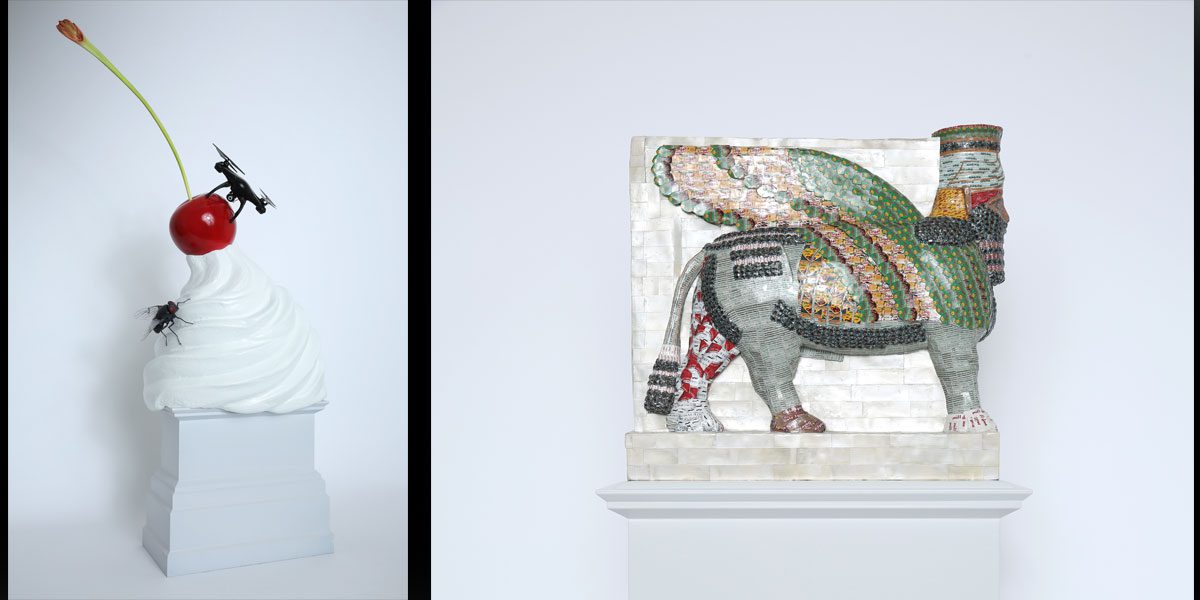The next two occupants of the so-called Fourth Plinth Commission in Trafalgar Square have just been announced and, true to form, the British visual arts establishment has laboured and given birth to a mouse. Or, to be fair, to two mice, one of them just slightly larger than the other. I speak not in terms of size, but in those of probable effect.
The two works chosen are, respectively, the replica of a winged bull from Nineveh, destroyed by Isis, which is to be reconstructed here using empty Iraqi date syrup cans (the work of Michael Rakowitz); and a piece called The End, by Heather Phillipson, which will consist of a giant whirl of whipped cream topped with a cherry and also – ahem – with what are described as ‘parasites’. The official description of this latter piece gushes as follows:
‘One breathes a sigh of gratitude for the frivolity and impermanence of what appears on the Fourth Plinth.’ – ELS
“The work explores the extremes of shared experience, from commemorations and celebrations to mass protests, all while being observed by a drone’s camera. THE END represents exuberance and unease. Topped with a giant, unstable load, the plinth becomes a monument to hubris and impending collapse.”
The final choice can fairly be described as nobody’s fault. As Justine Simons, Deputy Mayor for Culture and the Creative Industries, pointed out when making the announcement: “Over 9,000 people have had their say on what was an incredible shortlist.” Democracy rules – shut your yap and don’t complain. Things might be slightly worse. At the moment the plinth is occupied by a giant digit by David Shrigley, giving London the finger.
What is fascinating, though only in a dismal way, about these recent ventures into the always rather contentious field of public sculpture is the fear of – God forbid! – being taken entirely seriously. The Nineveh bull is indeed serious in a peripheral kind of way, in that it comments on a continuing political and cultural catastrophe taking place in the Middle East. However, the date syrup cans used for making a replica of the monument do, like it or not offer a rather ambiguous message. The suggestion, if you choose to read it that way, is that the monuments of the past are really just another form of trash. A superior form, if you insist, but on their way to the rubbish heap in the contemporary world, where everything is disposable.
The giant whipped cream desert is even more unambiguous in its upfront assertion that nothing endures for more than a moment – monuments, it declares, are a contradiction in terms. ‘Tout passe, tout casse, tout lasse’ – as the cynical French proverb has it. Nothing lasts, everything breaks, everything wearies us.
It’s when one considers what a truly ‘serious’ contemporary monument might be like – e.g. a colossal bronze figure celebrating the glory of Donald Trump, complete with gilded comb-over, erected in Parliament Square at the behest of Theresa May in gratitude for the Donald’s assistance over Brexit – that one breathes a sigh of gratitude for the frivolity and impermanence of what appears on the Fourth Plinth.
In terms of appropriate silliness and triviality what turns up there does supply a suitable, mercifully ephemeral, commentary on the times we live in. And when the whipped cream monument has been and gone, it can still live out a spectral life as somebody’s screensaver. Nobody would grudge it that. Gone but not forgotten, as they say.
Words: Edward Lucie-Smith © Artlyst 2017

